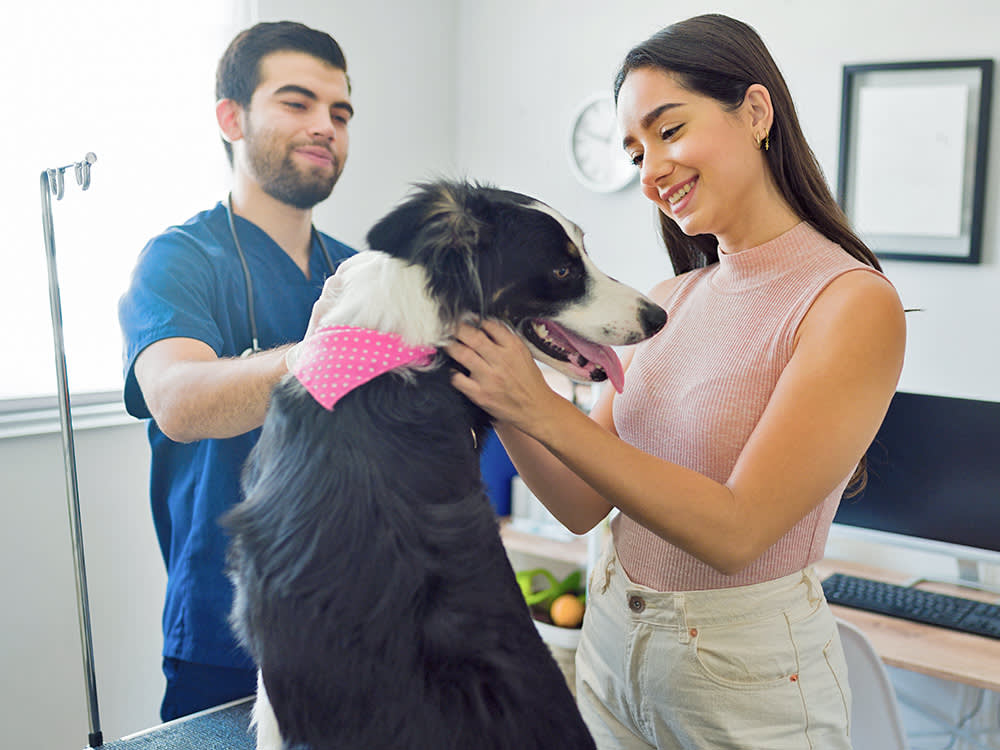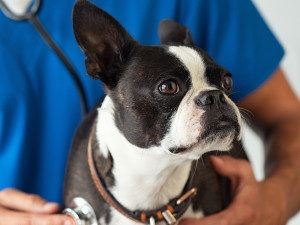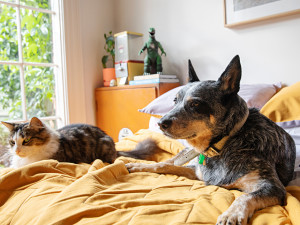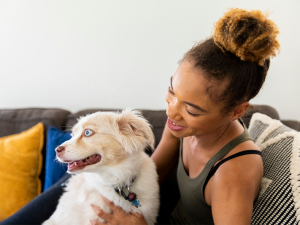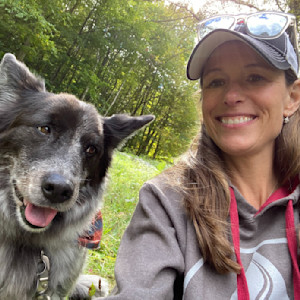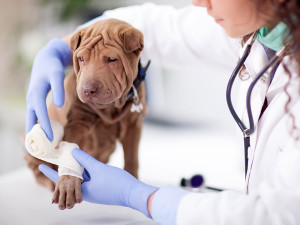How Much Does a Vet Visit Cost? Average Cost in 2025
Don’t get freaked out by the cost of pet parenthood—get prepared.
In This Article:
Factors That Influence Vet Visit Costs Average Vet-Visit Costs Average Vet-Visit Costs for Cats vs. Dogs How to Manage Vet Expenses
The unconditional love from your pet is priceless. The vet bills to keep them healthy? Not so priceless. When it’s time to take your pet to the veterinarian, you’re likely dreading the visit as much as they are, for very different reasons. Why are vets so expensive? And is there any way to reduce the cost of vet visitsopens in new tab?
Many different factors affect how much you’ll spend at the vet, not least of which is unexpected medical care. You may find yourself paying anywhere from $150 to more than $1,000, which can be hard to absorb, no matter how much you love your pet.
Dr. Gary Dattner, the chief veterinary officer at Tandem Vet Careopens in new tab, has more than 30 years of experience in the industry. “Appointment types and services provided are typically the biggest factors in the overall costs associated with vet visits,” he says. “Routine check-ups, vaccination appointments, or annual exams generally cost the same amount from visit to visit, while unexpected appointments needing diagnostics such as X-rays, blood or urine panels, or administered medications, can drastically fluctuate in pricing.”
How much do you spend on your pet per year?
Factors that influence vet costs
“Vet visit costs are determined by a number of factors, usually including appointment type, urgency, location, or services provided,” Dr. Dattner says. “For example, a dog in need of a routine vaccination during a physical exam will typically run at a much lower cost than a cat with a urinary blockage needing immediate attention at an emergency clinic.”
Location
Unfortunately, the cost of vet care is contingent on the cost of living. As with many other expenses, veterinary care costs more in cities and coastal regions compared to other parts of the country.
Type of clinic
Dr. Hunter Finn, owner of Pet Method Animal Hospitalopens in new tab in McKinney, Texas, says private clinics tend to cost more than community or nonprofit options.
Type of pet
In general, cats are less expensive than dogs, whose costs vary widely according to size and breed. Dr. Finn says larger dogs tend to need more medication and anesthesia. Larger dogs are also more susceptible to joint issues. Some breeds, such as Bulldogs and German Shepherds, are predisposed to health issues. Meanwhile, senior petsopens in new tab may need more care due to age-related health concerns, while puppies and kittens need multiple rounds of core vaccines.
Emergency vs. regular visits
Routine annual check-ups and vaccines are fixed, predictable costs. However, the cost of any routine or emergency visit goes up with blood work and screenings, especially those that use medical equipment. Then there are other costs such as spay and neuter surgeries, dental cleanings, treatment for diseases, parasites or infections, and medication such as flea and tick prevention. Surgery and specialty care will add to the bill.
Average vet-visit costs
Christie Horvath, founder-CEO of the pet insurance and pet wellness company Wagmoopens in new tab, says pet costs have increased in recent years. According to a 2024 Wagmo survey of more than 1,000 full-time US employees who own pets, 57 percent spent more than $1,000 on pet-related expenses in the previous year. More than one-third (35 percent) had spent in excess of $2,000. Because of this financial burden, the survey reports that 65 percent of employed pet parents say pet benefits are important when considering a job offer.
Horvath cites an American Pet Products Association survey stating that pet-industry expenditures in the US totaled $147 billion in 2023, up 7.5 percent from $136.8 billion in 2022. She adds that, according to Lending Tree, 37 percent of US consumers have gone into debt for their pet. She also cites a Synchrony survey that found the average lifetime cost of careopens in new tab ranges from $20,000 to $55,000 for dogs and $15,000 to $45,000 for cats.
At the very lowest, the average vet visit for a dog or cat ranges from $40 to $80, including the office fee and a basic examination. This cost goes up with additional charges for:
Vaccinations or booster shots ($15 to $100)
Testing (heartworm testsopens in new tab, for instance, average $35 to $75)
Fecal exams ($25 to $75)
Blood work and urinalysis ($100 to $300)
Dental work ($150 to $5750 or more, depending on the pet’s size and the need for oral surgery)
Keep in mind that these are just averages, and costs may be higher or lower based on your location, your pet’s age, and other factors.
Routine vet visit costs
A routine veterinary visit is usually $50 to $75 for either cats or dogs, but can run $250 or more depending on which vaccinations, testing, or other care your pet needs.
Dental cleaning
Dr. Finn places dental cleanings for dogs at $300 to $2,000, depending on the need for tooth extractions or other oral surgery. For cats, he estimates a range of $300 to $800, depending on their surgical needs as well.
Parasite prevention and treatment
It’s imperative to protect your pet (and you and your family) from parasites such as fleas and ticks. Plan on $20 to $30 per pet for a combined monthly preventative. Oral medication, topical treatment, and collars cost anywhere from $40 to $200, depending on your pet’s size and the length of treatment. Heartworm prevention ranges from $30 to more than $100. Like flea and tick prevention, it costs less if purchased in bulk.
Vaccinations
Vaccinations for puppies include distemper, adenovirus, parvovirus, and rabies. Kittens receive multiple vaccines for feline viral rhinotracheitis, feline calicivirus, and feline panleukopenia. Dr. Finn says these essential early-life costs average $20 to $65 per dose for puppies, and $20 to $45 for kittens.
Spaying and neutering
For new pet parents, spaying or neuteringopens in new tab is one of the biggest veterinary costs. Dr. Finn says these recommended surgeries average $250 to $525 for dogs and $200 to $400 for cats. If you adopt from a shelter or rescue, many will cover the cost of spaying and neutering. Several communities also offer low-cost spay/neuter clinics.
Basic blood work and diagnostic tests
Pets often need blood work for an accurate diagnosis of a particular illness. This can include anything from heartworm testing ($45 to $50) to allergy testing ($80 to $300) to testing for specific conditions such as feline leukemia virus ($60 to $120).
First vet-visit cost
Adopting a puppy or kitten comes with plenty of fun — and significant expenses. A first vet visit can be pricey, but it’s critical to establish care with a vet and ensure your new family member is healthy. During this initial visit, your puppy, for instance, may receive a number of vaccinations (see above). On top of the office fee and basic exam, vaccinations and booster shots cost $15 to $100 each, so your first vet visit could cost anywhere from $100 to $300.
Emergency vet-visit cost
A visit to an emergency vet clinicopens in new tab is almost inevitable. I’m still shaken by the sight of my dog Willy bleeding on the side of the road after being hit by a car while he was chasing a squirrel. The huge bill for the after-hours emergency visit was memorable, too.
Dr. Finn says the average emergency visit is $150 to $5,000 for dogs, depending on the service, and $150 to $3,000 for cats. (This depends on the nature of the emergency.) Surgery and hospitalization top the list of expensive, unanticipated care and vary widely depending on the type of surgery and length of stay. Medications, lab tests and diagnostics, and administrative fees also add to these bills.
Additional costs
Many vet clinics offer additional services such as grooming, boarding, and daycare. Boarding and daycare costs are charged by the day and vary widely depending on your location and the type of care (for instance, one-mile walk or a two-mile walk?). Grooming costs depend on your pet’s size and breed, as well as whether or not they need a quick bath and nail trim or a full haircut.
Average vet-visit costs for cats vs. dogs
Routine vet visits for both dogs and cats tend to run around the same price, from $50 to $250, depending on your location and the type of care your pet needs. The average cost of a vet visit for cats and dogs will also vary depending on which vaccinations they need.
Differences in common health issues and preventive care needs
Both dogs and cats need regular veterinary check-ups to monitor their health and detect any potential issues, such as parasites. Dogs are more likely to have joint issues, especially as they age, while cats need to be tested for common diseases like feline leukemia (FeLV). Your veterinarian can suggest testing based on your pet’s species, breed, and age.
Average costs for routine check-ups
A routine check-up can cost anywhere from $50 to $250. The visit itself for a basic exam is typically less than $100, with additional charges for vaccinations, prescriptions, diagnostics, and other care. For example, vaccines average $20 to $65 per shot, and a fecal exam costs an additional $25 to $75.
Spaying/neutering costs
For new pet parents, spaying or neuteringopens in new tab is one of the biggest veterinary costs. For cats, this surgery averages $50 to $500, depending on the pet’s sex, age, and other factors. For dogs, it’s $150 to $600. Fortunately, if you’re on a budget, you can look for low-cost spay/neuter clinics in your area. And if you adopt from a shelter or rescue, many organizations will handle the cost of the surgery for you.
How to manage vet expenses
Fortunately, there are ways to offset veterinary care through pet insurance, wellness plans, preventative care, and payment plans — whether through a pet health-care savings plan or directly through your vet.
Being honest about what you can pay — and requesting a pre-treatment estimate — is one of the many ways you can save money on vet billsopens in new tab. “Pet parents should consider veterinary services and clinics that offer fully transparent pricing,” Dattner says. “Nothing is worse than a surprise bill for something you weren’t expecting, so having a clear idea of how much services will cost is essential in properly planning the best care for your pet.”
You can also approach one of the many pet-specific financial supportopens in new tab organizations, foundations, and crowdfunding sites that offer credit and creative-payment options. Lastly, consider a second opinionopens in new tab for non-emergency surgery.
Pet insurance and wellness plans
Although most bills generally need to be paid upfront, an insurance policy ensures you’ll receive at least partial reimbursement. Dr. Robyn Jaynes, opens in new tab director of Veterinary Affairs at PetSmart Charitiesopens in new tab, says pet insurance is ideal for covering unexpected veterinary expenses. She notes: “Pet owners should evaluate their finances and consider options like payment plans or low-cost clinics. Understanding plan details, such as coverage for pre-existing conditions, is crucial.”
Ultimately, pet insurance gives pet parents peace of mind. “I always recommend people get pet insurance when their pets are young and healthy,” she says. “It’s the least expensive it will ever be and ensures that future health issues are covered, as long as they aren’t incurable pre-existing conditions.” Older pets, however, may not be covered for pre-existing conditions. “In that case, you might want to consider a wellness plan or an accident-only policy with a higher deductible,” Horvath says.
Horvath says the best-case scenario is getting pet insurance as early as possible to ensure complete coverage. If your pet is older or has pre-existing conditions that preclude coverage, a wellness plan can cover preventative care. Wagmo offers one for all pets, regardless of age, breed, or pre-existing conditions. “While wellness doesn’t cover emergencies, accidents, or illnesses, it can help with the day-to-day expenses of keeping your pet healthy. Even pets with pre-existing conditions need their annual exams and vaccines,” Horvath says.
Preventative care
Dr. Finn advises a proactive approach to care by staying up-to-date on vaccinations and visiting your vet for regular wellness exams. “This can help keep your pet protected before an emergency strikes,” he says. “However, if unexpected health challenges do arise, pet insurance can be a real lifesaver. And by enrolling while your pet is still healthy, you can make the most out of your policy.”
Dr. Dattner likewise recommends practicing good dental hygiene and providing regular exercise, enrichment, and a balanced diet. “Owners can lessen the likelihood of an unexpected vet visit,” he says. Additionally, he says pet parents can proactively prevent issues such as heatstroke, poisoning, and weather-related injuries by staying aware of geographic concerns such as intense heat, rattlesnake season, weather conditions, and the time of year poisonous plants bloom.
Payment plans
Don’t deny your pet care because you’re embarrassed about asking about payment policies. Dr. Jaynes says some clinics have access to grants and angel funds. Many offer low-interest payment plans. She advises always reading the terms of a payment plan carefully for credit-check requirements and (possible) high interest rates. PetSmart Charities publishes “Veterinary Care on a Budget: 5 Tips to Find Affordable Pet Care Optionsopens in new tab,” an extension of its most recent surveyopens in new tab about the state of pet care in partnership with Gallup. “It highlights the current landscape of accessible vet care — all from the pet parent’s perspective,” Dr. Jaynes says.
FAQs
Why are vet bills so expensive?
Just like medical doctors, veterinarians have the training and expertise required to treat your pet for a variety of health issues, as well as prescribe medications. Veterinarians also have to run a clinic, which includes bills, purchasing up-to-date equipment, and paying their staff.
What is the average cost of a vet visit for a cat?
A standard yearly check-up or wellness exam for a cat is usually around $100 to $200, but may be more depending on your location and other factors.
What is the average cost of a vet visit for a dog?
The average cost of a regular vet visit for a dog is anywhere from $50 to $250, depending on what vaccinations your dog requires.
References
PetSmart Charities (2025). New Study Finds More Than Half of U.S. Pet Parents Skip or Decline Needed Veterinary Care, PR Newswire, www.prnewswire.com/news-releases/new-study-finds-more-than-half-of-us-pet-parents-skip-or-decline-needed-veterinary-care-302429953.htmlopens in new tab.
Randolph, Kayla (2025). How Much Do Pet Vaccinations Cost? U.S. News & World Report, www.usnews.com/insurance/pet-insurance/how-much-do-pet-vaccinations-costopens in new tab.
PetSmart Charities (2025). Veterinary Care on a Budget: 5 Tips to Find Affordable Pet Care Options, petsmartcharities.org/sites/default/files/PetSmartCharities_StateOfPetCare_PetParentTips.pdfopens in new tab.
